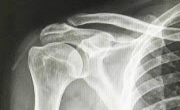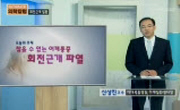목적: 봉합할 수 없는 광범위 회전근 개 파열에서 관절경적 결절 성형술 후 임상적, 방사선학적 결과를 분석하고자 하였다. 대상 및 방법: 2004년 12월에서 2007년 4월까지 광범위 회전근 개 ...
http://chineseinput.net/에서 pinyin(병음)방식으로 중국어를 변환할 수 있습니다.
변환된 중국어를 복사하여 사용하시면 됩니다.
- 中文 을 입력하시려면 zhongwen을 입력하시고 space를누르시면됩니다.
- 北京 을 입력하시려면 beijing을 입력하시고 space를 누르시면 됩니다.
https://www.riss.kr/link?id=A99571523
- 저자
- 발행기관
- 학술지명
- 권호사항
-
발행연도
2009
-
작성언어
Korean
-
주제어
Shoulder ; Rotator cuff tear ; Arthroscopic repair ; Tuberoplasty ; 견관절 ; 회전근 개 파열 ; 관절경적 봉합술 ; 결절 성형술
-
KDC
514
-
등재정보
KCI등재
-
자료형태
학술저널
- 발행기관 URL
-
수록면
7-13(7쪽)
-
KCI 피인용횟수
0
- DOI식별코드
- 제공처
-
0
상세조회 -
0
다운로드
부가정보
국문 초록 (Abstract)
대상 및 방법: 2004년 12월에서 2007년 4월까지 광범위 회전근 개 파열로 관절경적 결절 성형술을 시행한 11예를 대상으로 하였다. 추시 기간은 평균 17.3개월, 평균 연령은 61.7세였다. 5예는 관절경적 결절 성형술을, 6예는 관절경적 견봉하 감압술도 함께 시행하였다.
결과: Constant 점수와 UCLA 점수는 수술 전 각각 평균 61.8점과 14.8점에서 수술 후 평균 86.9점, 31.8점으로 향상되었고, 최우수 6예, 우수 3예, 불량 2예였다(p<0.001, p=0.003). 능동적 전방 거상은 111.8도에서 154.1도로 향상되었다(p=0.011). 견봉상완 간격은 수술 전 평균 3.94 mm에서 수술 후 평균 4.22 mm로 측정되었다(p=0.12). 불량인 2예는 수술 전 견봉상완 간격이 평균 1.67 mm에서 수술 후 0.94 mm로 감소되었다.
결론: 봉합할 수 없는 광범위 회전근 개 파열에서 관절경적 결절 성형술은 통증 완화 및 운동 범위 증가의 효과를 얻었으나, 수술 전 견봉상완 간격이 2 mm 이하이고 술후에 더 좁아진다면 좋은 결과를 기대하기 어렵다.
목적: 봉합할 수 없는 광범위 회전근 개 파열에서 관절경적 결절 성형술 후 임상적, 방사선학적 결과를 분석하고자 하였다.
대상 및 방법: 2004년 12월에서 2007년 4월까지 광범위 회전근 개 파열로 관절경적 결절 성형술을 시행한 11예를 대상으로 하였다. 추시 기간은 평균 17.3개월, 평균 연령은 61.7세였다. 5예는 관절경적 결절 성형술을, 6예는 관절경적 견봉하 감압술도 함께 시행하였다.
결과: Constant 점수와 UCLA 점수는 수술 전 각각 평균 61.8점과 14.8점에서 수술 후 평균 86.9점, 31.8점으로 향상되었고, 최우수 6예, 우수 3예, 불량 2예였다(p<0.001, p=0.003). 능동적 전방 거상은 111.8도에서 154.1도로 향상되었다(p=0.011). 견봉상완 간격은 수술 전 평균 3.94 mm에서 수술 후 평균 4.22 mm로 측정되었다(p=0.12). 불량인 2예는 수술 전 견봉상완 간격이 평균 1.67 mm에서 수술 후 0.94 mm로 감소되었다.
결론: 봉합할 수 없는 광범위 회전근 개 파열에서 관절경적 결절 성형술은 통증 완화 및 운동 범위 증가의 효과를 얻었으나, 수술 전 견봉상완 간격이 2 mm 이하이고 술후에 더 좁아진다면 좋은 결과를 기대하기 어렵다.
다국어 초록 (Multilingual Abstract)
Materials and Methods: Eleven patients underwent arthroscopic tuberoplasty for irreparable massive rotator cuff tears between December 2004 and April 2007. The mean follow-up period was 17.3 months, and the average age at the time of surgery was 61.7-year-old. Five cases underwent arthroscopic tuberoplasty and 6 cases had arthroscopic subacromial decompression and tuberoplasty, simultaneously.
Results: The average Constant score improved from 61.8 to 86.9 and the average UCLA score changed from 14.8 to 31.8 with 6 excellent, 3 good and 2 poor results (p=0.003). The active forward flexion improved from 111.8° to 154.1° (p=0.011). The acromiohumeral interval increased from 3.94 mm preoperatively to 4.22 mm postoperatively (p=0.12). In the poor UCLA score group, the acromiohumeral interval changed from 1.67 mm preoperatively to 0.94 mm postoperatively.
Conclusion: Arthroscopic tuberoplasty may be a second option to relieve the pain of irreparable massive rotator cuff tears and improve the range of motion. However, good results could not be expected if the acromiohumeral interval is < 2 mm preoperatively and decreased postoperatively.
Purpose: To evaluate the clinical and radiological results of arthroscopic tuberoplasty for irreparable massive rotator cuff tears. Materials and Methods: Eleven patients underwent arthroscopic tuberoplasty for irreparable massive rotator cuff tear...
Purpose: To evaluate the clinical and radiological results of arthroscopic tuberoplasty for irreparable massive rotator cuff tears.
Materials and Methods: Eleven patients underwent arthroscopic tuberoplasty for irreparable massive rotator cuff tears between December 2004 and April 2007. The mean follow-up period was 17.3 months, and the average age at the time of surgery was 61.7-year-old. Five cases underwent arthroscopic tuberoplasty and 6 cases had arthroscopic subacromial decompression and tuberoplasty, simultaneously.
Results: The average Constant score improved from 61.8 to 86.9 and the average UCLA score changed from 14.8 to 31.8 with 6 excellent, 3 good and 2 poor results (p=0.003). The active forward flexion improved from 111.8° to 154.1° (p=0.011). The acromiohumeral interval increased from 3.94 mm preoperatively to 4.22 mm postoperatively (p=0.12). In the poor UCLA score group, the acromiohumeral interval changed from 1.67 mm preoperatively to 0.94 mm postoperatively.
Conclusion: Arthroscopic tuberoplasty may be a second option to relieve the pain of irreparable massive rotator cuff tears and improve the range of motion. However, good results could not be expected if the acromiohumeral interval is < 2 mm preoperatively and decreased postoperatively.
참고문헌 (Reference)
1 Fenlin JM, Jr, "Tuberoplasty: creation of an acromiohumeral articulation-a treatment option for massive, irreparable rotator cuff tears" 1 : 136-142, 2002
2 Neviaser JS, "The repair of chronic massive ruptures of the rotator cuff of the shoulder by use of a freeze-dried rotator cuff" 60 : 681-684, 1978
3 Rhee YG, "Thailoo BBBR: The “3 Sister Portals”for arthroscopic repair of massive rotator cuff tears" 8 : 53-57, 2007
4 Adamson GJ, "Ten-year assessment of primary rotator cuff repairs" 2 : 57-63, 1993
5 Nobuhara K, "Surgical procedure and results of repair of massive tears of the rotator cuff" 54 (54): 1994
6 Hawkins RJ, "Surgery for full-thickness rotator-cuff tears" 67 : 1349-1355, 1985
7 Cofield RH, "Subscapular muscle transposition for repair of chronic rotator cuff tears" 154 : 667-672, 1982
8 Neviaser JS:, "Ruptures of the rotator cuff of the shoulder. New concepts in the diagnosis and operative treatment of chronic ruptures" 102 : 483-485, 1971
9 Scheibel M, "Reversed arthroscopic subacromial decompression for massive rotator cuff tears" 13 : 272-278, 2004
10 Ellman H, "Repair of the rotator cuff. End-result study of factors influencing reconstruction" 68 : 1136-1144, 1986
1 Fenlin JM, Jr, "Tuberoplasty: creation of an acromiohumeral articulation-a treatment option for massive, irreparable rotator cuff tears" 1 : 136-142, 2002
2 Neviaser JS, "The repair of chronic massive ruptures of the rotator cuff of the shoulder by use of a freeze-dried rotator cuff" 60 : 681-684, 1978
3 Rhee YG, "Thailoo BBBR: The “3 Sister Portals”for arthroscopic repair of massive rotator cuff tears" 8 : 53-57, 2007
4 Adamson GJ, "Ten-year assessment of primary rotator cuff repairs" 2 : 57-63, 1993
5 Nobuhara K, "Surgical procedure and results of repair of massive tears of the rotator cuff" 54 (54): 1994
6 Hawkins RJ, "Surgery for full-thickness rotator-cuff tears" 67 : 1349-1355, 1985
7 Cofield RH, "Subscapular muscle transposition for repair of chronic rotator cuff tears" 154 : 667-672, 1982
8 Neviaser JS:, "Ruptures of the rotator cuff of the shoulder. New concepts in the diagnosis and operative treatment of chronic ruptures" 102 : 483-485, 1971
9 Scheibel M, "Reversed arthroscopic subacromial decompression for massive rotator cuff tears" 13 : 272-278, 2004
10 Ellman H, "Repair of the rotator cuff. End-result study of factors influencing reconstruction" 68 : 1136-1144, 1986
11 Worland RL, "Repair of massive rotator cuff tears in patients older than 70 years" 8 : 23-30, 1999
12 Debeyre J, "Repair of Ruptures of the Rotator Cuff of the Shoulder" 47 : 36-42, 1965
13 Ozaki J, "Reconstruction of chronic massive rotator cuff tears with synthetic materials" 202 : 173-183, 1986
14 Gartsman GM, "Massive, irreparable tears of the rotator cuff. Results of operative debridement and subacromial decompression" 79 : 715-721, 1997
15 Duralde XA, "Massive rotator cuff tears: the result of partial rotator cuff repair" 14 : 121-127, 2005
16 Melillo AS, "Massive rotator cuff tears: debridement versus repair" 28 : 117-124, 1997
17 McLaughlin HL, "Lesions of the musculotendinous cuff of the shoulder. I. The exposure and treatment of tears with retraction" 26 : 31-51, 1944
18 Gerber C, "Latissimus dorsi transfer for the treatment of irreparable tears of the rotator cuff" 275 : 152-160, 1992
19 Grammont PM, "Delta shoulder prosthesis for rotator cuff rupture" 16 : 65-68, 1993
20 Rockwood CA, Jr, "Debridement of degenerative, irreparable lesions of the rotator cuff" 77 : 857-866, 1995
21 Bishop J, "Cuff integrity after arthroscopic versus open rotator cuff repair: a prospective study" 15 : 290-299, 2006
22 Burkhart SS, "Arthroscopic treatment of massive rotator cuff tears. Clinical results and biomechanical rationale" 45-56, 1991
23 Zvijac JE, "Arthroscopic subacromial decompression in the treatment of full thickness rotator cuff tears: a 3- to 6-year follow-up" 10 : 518-523, 1994
24 Tauro JC, "Arthroscopic rotator cuff repair: analysis of technique and results at 2- and 3-year follow-up" 14 : 45-551, 1998
25 Ogilvie-Harris DJ, "Arthroscopic debridement versus open repair for rotator cuff tears. A prospective cohort study" 75 : 416-420, 1993
26 Burkhart SS, "Arthroscopic debridement and decompression for selected rotator cuff tears" 24 : 111-123, 1993
27 Blevins FT, "Arthroscopic assisted rotator cuff repair: results using a mini-open deltoid splitting approach" 12 : 50-59, 1996
28 Kempf JF, "A multicenter study of 210 rotator cuff tears treated by arthroscopic acromioplasty" 15 : 56-66, 1999
29 Constant CR, "A clinical method of functional assessment of the shoulder" 160-164, 1987
동일학술지(권/호) 다른 논문
-
Neer 분류 제 2형 원위부 쇄골 골절의 mini-T형 금속판 고정
- 대한견주관절의학회
- 염재광(Jae-Kwang Yum)
- 2009
- KCI등재
-
Wolter 금속판를 이용한 제 2형 원위부 쇄골 골절의 치료
- 대한견주관절의학회
- 신성일(Sung-Il Shin)
- 2009
- KCI등재
-
주관절 외상과염의 체외 충격파 시술에서 에너지량에 따른 치료 효과
- 대한견주관절의학회
- 오주한(Joo-Han Oh)
- 2009
- KCI등재
-
- 대한견주관절의학회
- Warner Jon JP
- 2009
- KCI등재
분석정보
인용정보 인용지수 설명보기
학술지 이력
| 연월일 | 이력구분 | 이력상세 | 등재구분 |
|---|---|---|---|
| 2027 | 평가예정 | 재인증평가 신청대상 (재인증) | |
| 2021-01-01 | 평가 | 등재학술지 유지 (재인증) |  |
| 2018-01-01 | 평가 | 등재학술지 유지 (등재유지) |  |
| 2015-01-01 | 평가 | 등재학술지 유지 (등재유지) |  |
| 2011-08-04 | 학술지명변경 | 외국어명 : Journal of Korean Shoulder and Elow Society -> Clinics in Shoulder and Elbow |  |
| 2011-01-01 | 평가 | 등재학술지 선정 (등재후보2차) |  |
| 2010-01-01 | 평가 | 등재후보 1차 PASS (등재후보1차) |  |
| 2008-01-01 | 평가 | 등재후보학술지 선정 (신규평가) |  |
학술지 인용정보
| 기준연도 | WOS-KCI 통합IF(2년) | KCIF(2년) | KCIF(3년) |
|---|---|---|---|
| 2016 | 0.04 | 0.04 | 0.07 |
| KCIF(4년) | KCIF(5년) | 중심성지수(3년) | 즉시성지수 |
| 0.06 | 0.07 | 0.255 | 0.02 |




 ScienceON
ScienceON DBpia
DBpia



